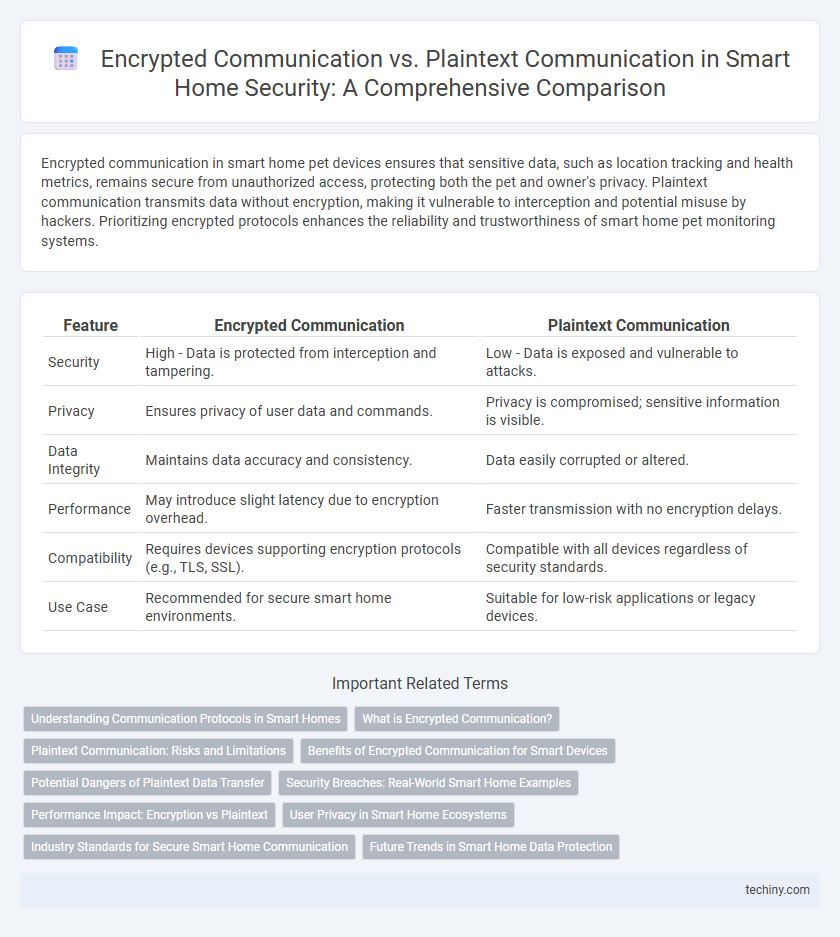Encrypted communication in smart home pet devices ensures that sensitive data, such as location tracking and health metrics, remains secure from unauthorized access, protecting both the pet and owner's privacy. Plaintext communication transmits data without encryption, making it vulnerable to interception and potential misuse by hackers. Prioritizing encrypted protocols enhances the reliability and trustworthiness of smart home pet monitoring systems.
Table of Comparison
| Feature | Encrypted Communication | Plaintext Communication |
|---|---|---|
| Security | High - Data is protected from interception and tampering. | Low - Data is exposed and vulnerable to attacks. |
| Privacy | Ensures privacy of user data and commands. | Privacy is compromised; sensitive information is visible. |
| Data Integrity | Maintains data accuracy and consistency. | Data easily corrupted or altered. |
| Performance | May introduce slight latency due to encryption overhead. | Faster transmission with no encryption delays. |
| Compatibility | Requires devices supporting encryption protocols (e.g., TLS, SSL). | Compatible with all devices regardless of security standards. |
| Use Case | Recommended for secure smart home environments. | Suitable for low-risk applications or legacy devices. |
Understanding Communication Protocols in Smart Homes
Encrypted communication in smart homes ensures the confidentiality and integrity of data by using protocols like WPA3 and TLS, safeguarding devices against unauthorized access and cyberattacks. Plaintext communication transmits data without encryption, making it vulnerable to interception and manipulation, which risks privacy and security of sensitive information in connected devices. Understanding these protocols helps homeowners and manufacturers implement robust security measures to protect smart home ecosystems from exploitation.
What is Encrypted Communication?
Encrypted communication in smart home systems ensures that data transmitted between devices is transformed into a secure code, preventing unauthorized access and safeguarding sensitive information. This method uses cryptographic algorithms such as AES or RSA to encode messages, making interception by hackers ineffective. Maintaining encrypted channels enhances privacy and security, crucial for protecting smart home controls, personal data, and IoT device interactions.
Plaintext Communication: Risks and Limitations
Plaintext communication in smart homes exposes sensitive data to interception, leading to potential breaches of privacy and unauthorized control of devices. Without encryption, attackers can exploit network vulnerabilities to monitor activity, manipulate device functionality, or launch malicious attacks. This lack of security undermines user trust and increases the risk of data theft, making plaintext communication unsuitable for protecting smart home systems.
Benefits of Encrypted Communication for Smart Devices
Encrypted communication safeguards smart home devices by protecting sensitive data from unauthorized access and cyber threats. It ensures confidentiality and integrity, preventing hackers from intercepting or manipulating commands sent between devices and control hubs. Enhanced security through encryption boosts user trust, enabling safer automation and remote management of smart home systems.
Potential Dangers of Plaintext Data Transfer
Plaintext communication in smart home devices exposes sensitive data to interception, increasing the risk of unauthorized access and data breaches. Without encryption, passwords, commands, and personal information can be easily captured and exploited by hackers. Encrypted communication ensures data integrity and confidentiality, preventing malicious actors from tampering with or stealing critical smart home information.
Security Breaches: Real-World Smart Home Examples
Encrypted communication in smart homes significantly reduces the risk of security breaches by protecting data from interception and unauthorized access. Real-world incidents demonstrate that plaintext communication exposes devices to hacking, allowing attackers to manipulate smart locks, cameras, and personal data. Implementing end-to-end encryption protocols ensures robust defense against cyber threats and preserves user privacy in connected home environments.
Performance Impact: Encryption vs Plaintext
Encrypted communication in smart home systems introduces processing overhead due to data encryption and decryption, which can slightly increase latency compared to plaintext communication. This performance impact is influenced by factors such as encryption algorithms (e.g., AES-256), device computational power, and network bandwidth. Despite the minor delay, encrypted communication significantly enhances data security, making it essential for protecting sensitive smart home information against cyber threats.
User Privacy in Smart Home Ecosystems
Encrypted communication in smart home ecosystems ensures that sensitive user data, such as voice commands and device statuses, remains confidential and protected from unauthorized access. Plaintext communication exposes vulnerabilities, making it easier for attackers to intercept and misuse personal information, compromising user privacy. Prioritizing end-to-end encryption protocols strengthens security by safeguarding data integrity and preventing eavesdropping within smart home networks.
Industry Standards for Secure Smart Home Communication
Industry standards such as Zigbee, Z-Wave, and Thread mandate encrypted communication protocols to protect smart home devices from unauthorized access and data breaches. These standards employ AES-128 encryption and mutual authentication to ensure that data transmitted between devices remains confidential and tamper-proof. Plaintext communication, lacking encryption, exposes smart home networks to vulnerabilities, making industry-compliant encrypted communication critical for securing connected environments.
Future Trends in Smart Home Data Protection
Future trends in smart home data protection emphasize encrypted communication to safeguard user privacy and prevent unauthorized access. Advanced encryption protocols like TLS 1.3 and end-to-end encryption are becoming standard to secure device-to-cloud and device-to-device interactions. As smart home ecosystems expand, the integration of blockchain technology and quantum-resistant algorithms will enhance the robustness of encrypted communication against emerging cyber threats.
Encrypted Communication vs Plaintext Communication Infographic

 techiny.com
techiny.com